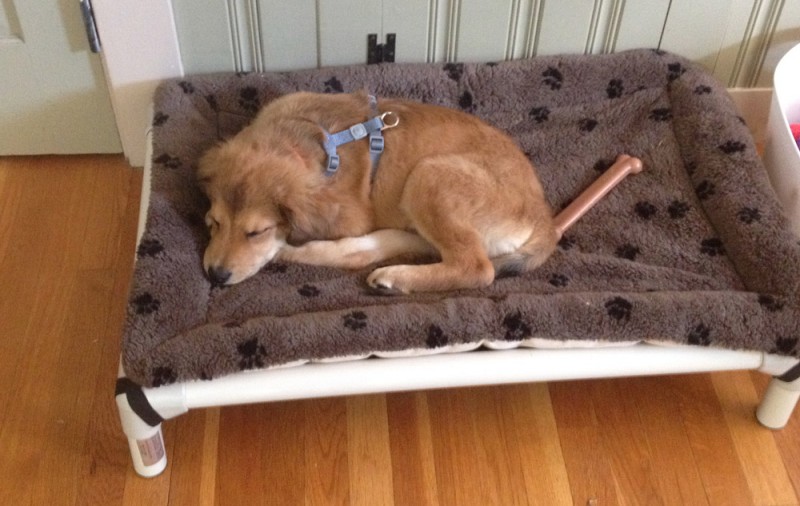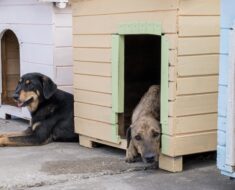How big should a dog bed be? Finding the right size bed for your dog is essential for their comfort and well-being.
Just like humans, dogs need a place to rest that fits their size, allowing them to stretch out, curl up, or find the perfect sleeping position.
A bed that’s too small can lead to discomfort, while one that’s too large may not provide the cozy feeling dogs love. The ideal dog bed should accommodate your pet’s breed, size, and sleeping habits.
Choosing the right size ensures your dog has a restful, comfortable space of their own.
Here can i spray laysol on dog bed?
How big should a dog bed be?
The size of a dog bed should be based on your dog’s breed, size, and sleeping habits. To determine the right size, measure your dog from nose to tail when they are lying down and add about 8-12 inches to ensure they have space to stretch comfortably.

For smaller dogs like Chihuahuas or Dachshunds, a small bed of around 18-24 inches in diameter may suffice. Medium-sized dogs like Beagles or Bulldogs usually require beds in the 30-36 inch range. Larger dogs like Golden Retrievers or German Shepherds often need beds that are 40-48 inches or larger.
Additionally, consider your dog’s preferred sleeping position—if they like to sprawl, a larger bed may be needed, while dogs that curl up might prefer something more snug. Ultimately, a properly sized bed offers both comfort and support, ensuring your dog gets the restful sleep they need.
What is a good size for a dog bed?
A good size for a dog bed depends on your dog’s breed, size, and sleeping style. To find the perfect fit, measure your dog from the tip of their nose to the base of their tail while they’re lying down. For most breeds, a bed should be at least 8-12 inches longer than this measurement.
- Small dogs (like Chihuahuas or Pomeranians) typically do well with beds that are 18-24 inches in diameter.
- Medium dogs (like Beagles or Bulldogs) usually require beds around 30-36 inches.
- Large dogs (like Golden Retrievers or German Shepherds) often need beds that are 40-48 inches or larger.
Additionally, consider the dog’s sleeping style; if they like to stretch out, a larger bed will provide more comfort. Ultimately, choosing a bed that allows your dog to lie down comfortably without feeling cramped will ensure they get a good night’s sleep.
Should a dog bed be bigger than the dog?
Yes, a dog bed should be bigger than the dog to ensure comfort and support. Ideally, the bed should allow for about 8-12 extra inches beyond the dog’s length when they are lying down.
This extra space enables your dog to stretch out, change positions easily, and find their preferred sleeping posture without feeling cramped. A larger bed also helps accommodate any natural movements during sleep, promoting better rest.
Here, can dogs ride on the back of the truck?
Additionally, having a bit of extra room can make the bed feel cozier and more inviting for your pet, enhancing their overall sleeping experience.
Do dogs like small beds or big beds?
Dogs generally prefer beds that cater to their individual sleeping styles and comfort needs. While some dogs enjoy curling up in smaller beds, feeling secure and snug, others prefer larger beds that allow them to stretch out.
Small beds can be ideal for small or toy breeds, as they offer a cozy space for them to nestle and feel safe. Breeds like Chihuahuas or Pomeranians often appreciate the snugness of a smaller bed.
On the other hand, larger breeds such as Golden Retrievers or Great Danes benefit from bigger beds that provide ample space for stretching and changing positions. These dogs may feel uncomfortable in cramped spaces, leading to disrupted sleep.
Ultimately, the best choice depends on your dog’s size, sleeping habits, and personal preferences. Observing how your dog uses their bed can help you determine whether they prefer the coziness of a small bed or the freedom of a larger one.
How do you know if your dog’s bed is too small?
Determining if your dog’s bed is too small involves observing their behavior and comfort levels. If your dog frequently hangs off the edges of the bed or their limbs are cramped when they lie down, it’s a sign that the bed may be too small.
Additionally, watch for signs of discomfort, such as restlessness, difficulty getting comfortable, or frequent changing of positions. If your dog appears to be struggling to find a cozy spot or seems anxious while resting, these may be indicators that their bed isn’t providing adequate space.
You may also notice your dog avoiding their bed altogether, opting to sleep on the floor or in other areas instead.
Finally, consider your dog’s growth; puppies, for example, may quickly outgrow their beds. Regularly assessing your dog’s sleeping habits and physical changes will help ensure they have a comfortable and supportive space to rest.
How large of a dog bed should i buy? Controller for scale
When selecting a dog bed, size is crucial for your dog’s comfort. A general rule is to measure your dog from the tip of their nose to the base of their tail while lying down and then add about 8-12 inches to that measurement.

For a visual scale, consider using a controller as a reference point. For instance, a standard gaming controller is approximately 6-7 inches long. Small dog beds, suitable for breeds like Chihuahuas or Dachshunds, typically measure around 18-24 inches in diameter, which is about 2-3 controllers wide.
Medium dog beds, ideal for Beagles or Bulldogs, range from 30-36 inches, roughly 4-5 controllers long. Large dog beds for breeds like Golden Retrievers can range from 40-48 inches, equivalent to 6-8 controllers.
This method can help you visualize the appropriate size, ensuring your dog has enough space to stretch and sleep comfortably.
Here, can dog be affected by bed bugs?
What factors should I consider when choosing a dog bed for my pet?
When choosing a dog bed for your pet, consider several key factors to ensure comfort and support.
- Size: Measure your dog from nose to tail and add 8-12 inches to find the appropriate bed size. Ensure it allows enough space for stretching and changing positions.
- Breed and Age: Different breeds have varying sleeping habits. Larger breeds often need bigger beds, while small breeds may prefer cozier options. Puppies and senior dogs may benefit from orthopedic beds for extra support.
- Material: Look for durable, non-toxic materials that can withstand wear and tear. Consider waterproof or washable options, especially for younger dogs or those prone to accidents.
- Sleeping Style: Observe your dog’s sleeping habits. Dogs that like to curl up may prefer a round bed, while those that stretch out may need a rectangular bed.
- Location: Consider where the bed will be placed; a bed for outdoor use may require different features than one for indoors.
10 types of dog bed sizes for dog
Here’s a table outlining 10 types of dog bed sizes, including their dimensions and suitable dog breeds:
| Dog Bed Size | Dimensions | Suitable Breeds |
|---|---|---|
| Extra Small (XS) | 18 x 12 inches | Chihuahuas, Toy Poodles, Dachshunds |
| Small (S) | 24 x 18 inches | Beagles, Shih Tzus, Pugs |
| Medium (M) | 30 x 20 inches | Cocker Spaniels, Bulldogs, French Bulldogs |
| Large (L) | 36 x 24 inches | Golden Retrievers, Labrador Retrievers |
| Extra Large (XL) | 42 x 28 inches | German Shepherds, Rottweilers |
| Giant (G) | 48 x 30 inches | Great Danes, Mastiffs |
| Orthopedic | Varies (usually 4-6 inches thick) | Older dogs, dogs with joint issues |
| Bolster Bed | Varies (usually 30-50 inches) | Dogs that like to curl up, various breeds |
| Cat Bed Size | 18 x 18 inches | Small dogs like Chihuahuas and Yorkies |
| Crate Mat | Varies (depending on crate size) | Any dog that uses a crate |
This table provides a quick reference for different bed sizes, helping you choose the best option for your dog’s needs.
Dog bed size chart by breed?
Choosing the right dog bed size by breed ensures your pet’s comfort and support. Here’s a brief size chart based on common dog breeds:
- Toy Breeds (e.g., Chihuahua, Pomeranian): Small (S), 18-24 inches.
- Small Breeds (e.g., Beagle, Dachshund): Small to Medium (M), 24-30 inches.
- Medium Breeds (e.g., Cocker Spaniel, Bulldog): Medium (M), 30-36 inches.
- Large Breeds (e.g., Golden Retriever, Boxer): Large (L), 36-42 inches.
- Extra Large Breeds (e.g., German Shepherd, Labrador Retriever): Extra Large (XL), 42-48 inches.
- Giant Breeds (e.g., Great Dane, Mastiff): Giant (G), 48 inches and above.
For puppies and senior dogs, consider orthopedic options for added support. Always measure your dog from nose to tail and add 8-12 inches to ensure they have ample space to stretch and relax comfortably.
This size chart helps guide you in finding the perfect bed for your furry friend.
How big should a dog bed be in inches?
The size of a dog bed should be tailored to your dog’s specific dimensions to ensure comfort and support.

A general guideline is to measure your dog from the tip of their nose to the base of their tail while lying down and then add 8-12 inches for optimal space. Here’s a quick reference for bed sizes in inches based on common dog sizes:
- Small Dogs: 18-24 inches (e.g., Chihuahuas, Dachshunds)
- Medium Dogs: 24-36 inches (e.g., Beagles, Cocker Spaniels)
- Large Dogs: 36-42 inches (e.g., Golden Retrievers, Boxers)
- Extra Large Dogs: 42-48 inches (e.g., German Shepherds, Labradors)
- Giant Dogs: 48 inches and above (e.g., Great Danes, Mastiffs)
Choosing a bed that accommodates your dog’s sleeping style—whether they prefer to curl up or stretch out—is crucial for their comfort. Proper sizing ensures they have a cozy space to rest and relax.
Dog bed size chart cm?
Here’s a dog bed size chart in centimeters to help you choose the right bed for your pet based on their size:
| Dog Size | Dimensions (cm) | Suitable Breeds |
|---|---|---|
| Extra Small (XS) | 45 x 30 cm | Chihuahuas, Toy Poodles |
| Small (S) | 60 x 45 cm | Beagles, Shih Tzus, Pugs |
| Medium (M) | 75 x 50 cm | Cocker Spaniels, Bulldogs |
| Large (L) | 90 x 60 cm | Golden Retrievers, Boxers |
| Extra Large (XL) | 105 x 70 cm | German Shepherds, Labrador Retrievers |
| Giant (G) | 120 x 80 cm | Great Danes, Mastiffs |
When selecting a bed, measure your dog from nose to tail and add 20-30 cm for extra comfort. This chart helps ensure your dog has ample space to stretch and relax, promoting better sleep and overall well-being.
Dog bed size for Labrador?
When selecting a dog bed for a Labrador Retriever, size and comfort are essential.
Labradors are medium to large dogs, typically weighing between 55-80 pounds (25-36 kg) and measuring around 21.5-24.5 inches (55-62 cm) in height. Therefore, a suitable dog bed should ideally be 36-42 inches (about 90-105 cm) in length to provide ample space for stretching out and changing positions comfortably.
Labradors often enjoy lounging and may prefer beds with some cushioning for joint support, especially as they age. Orthopedic beds are an excellent choice, offering additional support for their hips and joints.
Additionally, consider a bed with durable, washable covers, as Labradors are active and may bring dirt or water inside. Providing a cozy and appropriately sized bed will ensure your Labrador has a comfortable space to rest, promoting better sleep and overall well-being.
Can a dog bed be too big?
Yes, a dog bed can be too big for your pet, leading to potential discomfort and insecurity.
While it’s essential for a bed to provide ample space for your dog to stretch out and change positions, an overly large bed may not offer the necessary support and coziness that smaller dogs prefer.
Here, how to block dog bed going under the bed?
For instance, smaller breeds might feel lost in a bed that’s too spacious, resulting in restlessness or reluctance to use it. Additionally, a large bed may prevent them from feeling snug and secure, which can impact their ability to relax and sleep well.
Moreover, beds that are excessively large might not provide adequate warmth and support, especially for older dogs or those with joint issues. Choosing a bed that fits your dog’s size and sleeping style is crucial for their overall comfort, ensuring they have a cozy and supportive space to rest.
What size dog bed for German Shepherd?
When choosing a dog bed for a German Shepherd, size is crucial for ensuring comfort and support. German Shepherds are large dogs, typically weighing between 50-90 pounds (22-41 kg) and measuring about 22-26 inches (56-66 cm) in height.
Therefore, a suitable dog bed should ideally be 42-48 inches (approximately 107-122 cm) in length to provide ample space for them to stretch out comfortably.
Opting for an orthopedic bed can be beneficial, especially for older dogs or those prone to joint issues, as it provides extra support for their hips and back. Additionally, look for a bed with a durable, washable cover to withstand their active lifestyle.
Providing an appropriately sized bed will help your German Shepherd feel secure and comfortable, promoting better sleep and overall well-being. Remember to consider their sleeping habits, as some may prefer a bed with bolsters for added support and security.
Is my dogs bed too small?
Determining if your dog’s bed is too small involves observing their behavior and comfort levels. If your dog frequently hangs off the edges or seems cramped while lying down, it may indicate the bed is too small. Look for signs of discomfort, such as restlessness, difficulty finding a comfortable position, or frequent changing of positions.

If your dog often chooses to sleep on the floor or avoids their bed altogether, this might suggest they don’t feel secure or cozy in that space. Additionally, if you notice their limbs extending beyond the bed or if they seem to struggle to curl up comfortably, it’s likely time for a larger bed.
Another consideration is your dog’s growth; puppies may outgrow their beds quickly. Regularly assessing your dog’s sleeping habits and physical changes will help ensure they have a comfortable and supportive space to rest and sleep soundly.
Related faq’s
[Survey] Does dog bed size correlate with dog size?
Yes, dog bed size generally correlates with dog size, as providing an appropriately sized bed is crucial for a dog’s comfort and well-being.
Larger breeds, such as Great Danes or German Shepherds, require bigger beds to accommodate their length and weight. A bed that is too small can lead to discomfort, restrict movement, and impact sleep quality.
Conversely, smaller breeds, like Chihuahuas and Dachshunds, thrive in snug beds that offer them a sense of security. Beds that are too large for them may result in feelings of insecurity and restlessness.
Additionally, a dog’s sleeping habits play a role; some dogs prefer to stretch out, while others like to curl up. As such, measuring your dog from nose to tail and considering their sleeping style is essential when choosing a bed. Overall, selecting a bed that corresponds to your dog’s size helps ensure they have a comfortable and supportive resting space.
Where should my puppy sleep, crate or dog bed?
Deciding where your puppy should sleep—either in a crate or on a dog bed—depends on your training goals and your puppy’s needs.
A crate provides a safe, secure environment, helping with house training and creating a den-like space that many dogs find comforting. It can prevent destructive behavior when you’re not supervising.
On the other hand, a dog bed offers comfort and space for your puppy to stretch out and relax.
Consider starting with a crate for bedtime and training, then transitioning to a dog bed as your puppy becomes more confident and house-trained. Ultimately, both options can be beneficial at different stages.
What type of bed does your pup have?
Choosing the right type of bed for your puppy depends on their size, age, and sleeping habits. Many pet owners opt for orthopedic beds, which provide excellent support for growing joints and bones, especially for larger breeds. These beds often feature memory foam or extra cushioning, ensuring comfort during sleep.
Some pups may prefer bolster beds, which have raised edges that give them a sense of security while they curl up. If your puppy tends to chew or scratch, a chew-resistant bed can be a great choice, offering durability against those playful instincts.
For those in training, a crate bed can be beneficial, as it fits snugly in their crate and helps with house training. Additionally, if your puppy enjoys lounging in different spots, a cozy blanket or mat can be a versatile option. Ultimately, selecting a bed that caters to your pup’s specific needs will promote better sleep and overall well-being.
Bed size for greyhound?
Here’s a bed size recommendation for Greyhounds presented in a table format:
| Dog Size | Recommended Bed Size | Dimensions (inches) | Dimensions (cm) | Comments |
|---|---|---|---|---|
| Greyhound | Large | 42-48 inches | 107-122 cm | Greyhounds are slender and long, so they need a bed that allows them to stretch out comfortably. Orthopedic options are ideal for joint support. |
When selecting a bed, ensure it provides enough length for your Greyhound to lie flat and comfortably. Additionally, consider the bed’s materials to ensure durability and easy maintenance.
Conclusion
In conclusion, choosing the right size for a dog bed is essential for your pet’s comfort and overall well-being.
A bed that fits your dog properly allows for adequate space to stretch out, curl up, and find a comfortable sleeping position. Measure your dog from nose to tail and add a few inches to determine the ideal bed size. Consider their breed, age, and sleeping habits when making your selection.
A well-sized bed not only provides physical comfort but also promotes better sleep, helping your dog feel secure and rested. Investing in the right bed contributes to your furry friend’s happiness and health.






